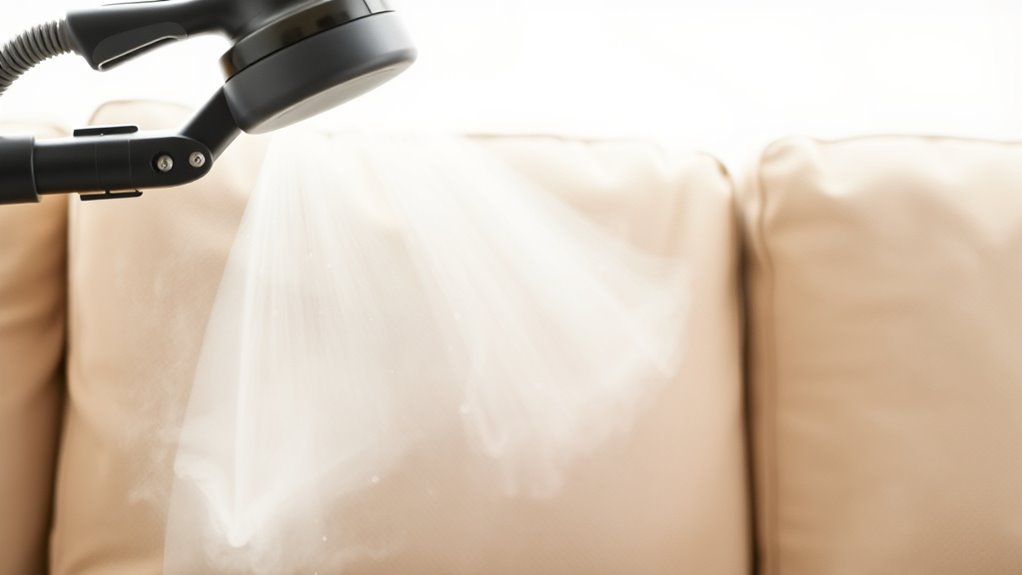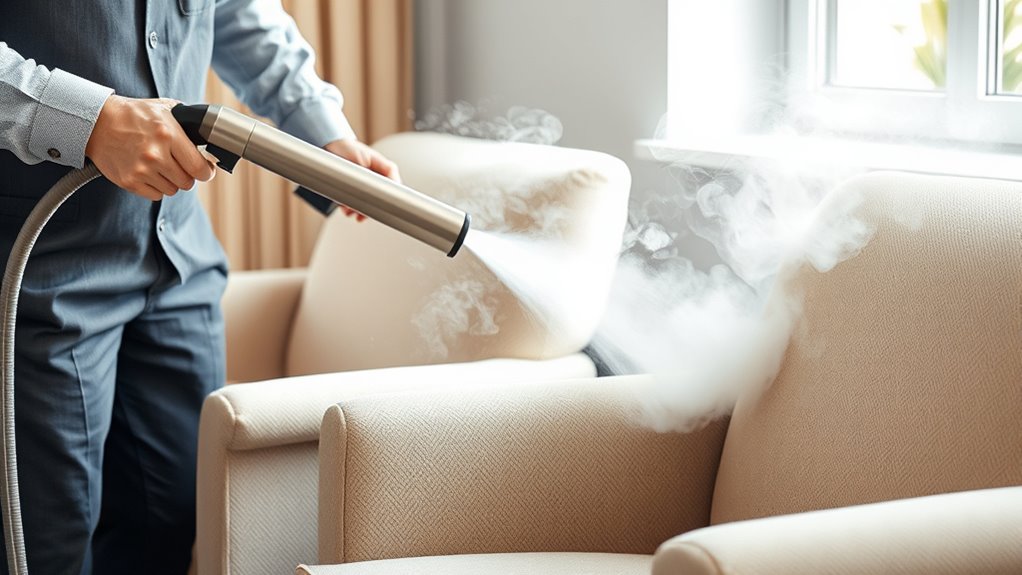To steam clean your upholstery, start by vacuuming thoroughly to remove loose dirt and debris. Test a small, hidden area with your high-quality steam cleaner to prevent damage. Use an appropriate attachment and maintain steady, even motions, keeping a safe distance from the fabric. For stubborn stains, pre-treat gently. Let your furniture air dry completely, maybe in the sun, to eliminate odors. For detailed steps and tips, keep exploring to guarantee a safe and effective clean.
Key Takeaways
- Identify fabric type and check cleaning instructions before starting.
- Vacuum upholstery thoroughly to remove loose dirt and debris.
- Test a small, hidden area with the steam cleaner to prevent damage.
- Use steady, controlled motions with the steam cleaner, maintaining proper distance.
- Allow furniture to air dry completely, enhancing ventilation and sun exposure if possible.

Steam cleaning upholstery is an effective way to remove dirt, stains, and allergens without harsh chemicals. It’s a method that uses hot vapor to penetrate deep into the fabric, loosening grime and killing germs. To get the best results, you need to understand the best cleaning techniques for your specific upholstery fabric types. Different fabrics require different approaches, so knowing how to identify and treat each one ensures you don’t damage your furniture. For example, delicate fabrics like silk or velvet need a gentle touch, while sturdier options like microfiber or polyester can handle a more thorough cleaning. Before you start, always check the manufacturer’s label for cleaning instructions, which often include fabric codes indicating whether steam cleaning is safe.
Use the right steam cleaning techniques for each fabric to protect your upholstery.
When selecting equipment, opt for a high-quality steam cleaner with adjustable settings. Many models come with different attachments designed for various upholstery types, so choose the right one for your furniture. Before applying steam, vacuum the upholstery thoroughly to remove loose dirt and debris. This step prevents dirt from embedding deeper during the cleaning process. Once prepped, test a small, inconspicuous area with the steam cleaner to ensure no discoloration or damage occurs. This is particularly important for delicate fabrics, which may react differently to heat or moisture.
As you proceed, keep the steam cleaner moving steadily across the fabric, avoiding prolonged contact on any one spot. This prevents over-saturation and potential water stains. Maintain a consistent distance from the upholstery to balance effective cleaning with safety. For stubborn stains, you might need to pre-treat with a mild, fabric-safe cleaner or spot remover before steaming. Remember, steam cleaning is best suited for removing surface dirt and bacteria rather than heavy stains or deep-set grime, so manage your expectations accordingly. Using a high-pressure steam cleaner ensures deeper penetration and more effective cleaning results.
After cleaning, allow the upholstery to air dry completely before use. Good ventilation speeds up drying, reducing the risk of mold or mildew. If your furniture has removable cushions, consider taking them outside to dry in the sun, which helps eliminate odors and bacteria further. Regular steam cleaning not only refreshes your upholstery but also prolongs its lifespan by preventing the buildup of allergens and dust mites. By employing the best cleaning techniques tailored to your fabric types, you ensure your furniture stays clean, healthy, and looking its best.
Frequently Asked Questions
How Often Should I Steam Clean My Upholstery?
You should steam clean your upholstery every 6 to 12 months, depending on your cleaning frequency and upholstery maintenance habits. If you have pets, kids, or allergies, consider doing it more often to keep your furniture fresh and free of allergens. Regular steam cleaning helps maintain your upholstery’s appearance, prolongs its lifespan, and keeps your living space healthier. Stay consistent with cleaning schedules for the best results.
Is Steam Cleaning Safe for Delicate Fabrics?
A stitch in time saves nine, so always check fabric safety first. Steam cleaning can be safe for delicate fabrics if you control the steam temperature and use gentle settings. Avoid high heat and excessive steam, which could damage fragile fibers. Always test a small, hidden area first to guarantee your upholstery can handle the process without harm. When in doubt, consult the manufacturer’s care instructions for your delicate fabrics.
Can Steam Cleaning Remove Pet Odors Completely?
Steam cleaning can considerably reduce pet odor, but it may not completely eliminate it on its own. For deep cleaning, use a steam cleaner combined with an enzymatic deodorizer designed for pet odors. These enzymes break down the odor-causing molecules, providing a more thorough clean. Regular steam cleaning helps maintain freshness, but persistent odors might require multiple treatments or professional deep cleaning to fully remove the pet smell.
What Should I Do if My Upholstery Gets Water Damage?
If your upholstery suffers water damage, don’t panic; it’s a common mishap that’s easier to fix than you think. Act quickly by blotting excess water with a dry towel, then use fans or a dehumidifier to dry the area thoroughly. For stubborn damage, consider professional upholstery repair. Prompt action minimizes mold growth and keeps your furniture looking pristine, saving you from costly replacements down the line.
Are There Specific Stains That Steam Cleaning Cannot Remove?
Certain stains, like chemical stains or ink, may be difficult to remove with steam cleaning alone. You might find that steam can’t fully eliminate these stubborn marks, especially if they’re deeply embedded or chemically treated. For ink removal, consider specialized solutions or professional help. Chemical stains often require specific cleaning agents, so don’t rely solely on steam. Knowing these limitations helps you choose the right cleaning method for your upholstery.
Conclusion
Now that you know how to steam clean your upholstery, you’ll keep your furniture looking fresh and extending its lifespan. Regular cleaning can remove up to 99% of germs and allergens, creating a healthier home environment. Just remember to follow the steps carefully and test a small area first. With a little effort, you’ll enjoy spotless, clean furniture that enhances your space and improves your overall well-being. Happy cleaning!









